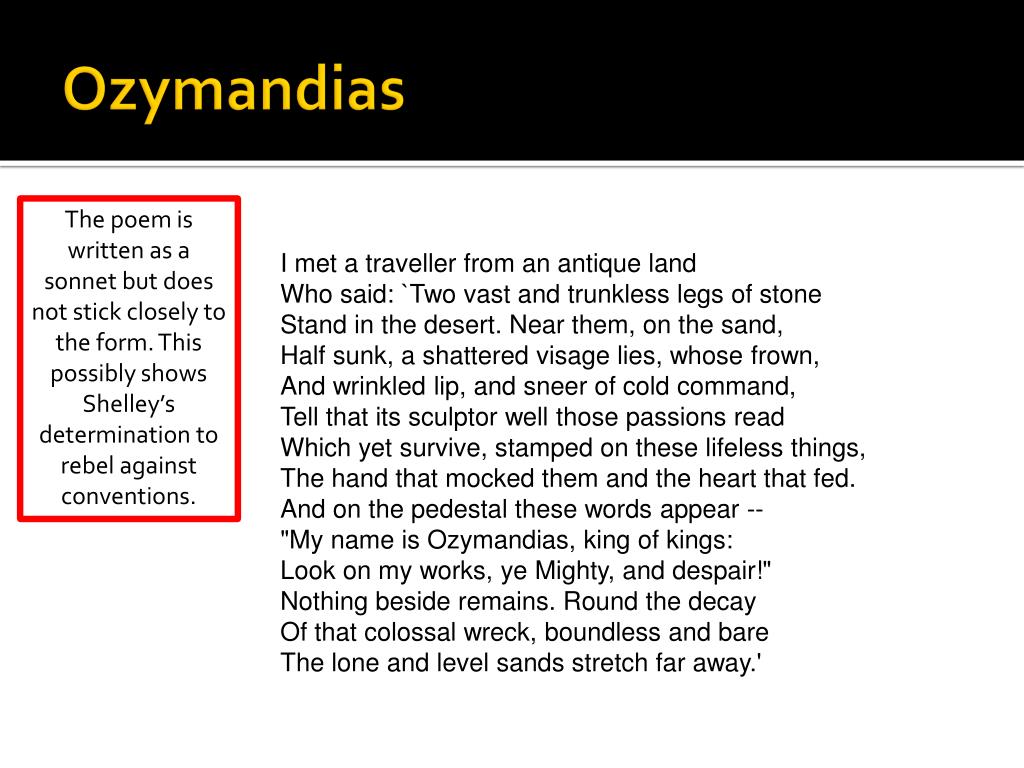
In a way, it makes you question what they are doing here… were they built in the desert or were they built in a civilisation that has now crumbled and has been swallowed up by the desert? It’s incongruous, these stone legs in the desert. Deserts also have the potential to swallow up civilisations that have departed, hiding all traces of them in a relatively short period of time.

A desert in itself is profoundly symbolic, because it is so devoid of life and civilisation. In the third line, the introduction of a desert scene is also evocative, since the desert is in itself a barren and deserted place. The word choice on these first three lines is simple and clear: no mystery here, except for the image itself. The tale he tells is this: two huge stone legs are all that remains standing of a statue. It goes right into the story itself, which is a weird and mysterious thing to do. It goes from ‘meeting’ the traveller to him recounting the tale: no ‘how’s it going?’ no ‘how are you?’ no ‘Would you like me to tell you a marvellous tale?’. I kind of imagine this traveller almost stopping Shelley in the street to share this tale with him. In the second line, we get the opening of the story he tells, which is kind of peculiar in itself. The fact that the traveller has no name and isn’t from a particular place just makes what he has to say even more universal. The universality of power is the message of the poem, and to have such a vague description is really great, because it leaves so much more to the imagination. It makes it more universal, as if many ancient civilisations could have such statues as he describes later. It could be Macchu Pichu, the Aztecs, the Incas, the Mayans, the Hun… the fact that Egypt is not mentioned specifically is important, because it means it’s also another level of vague old mystery. Still, it adds another little shot of mystery right in there, with the vagueness of the place. The “antique land” is a little ambiguous, as is the title, but you don’t have to be an Egyptologist to know that Egypt is the place in question. was born in) the antique land, since that just sounds more marvellously mysterious. he was born there?) or a traveller who’s come back from the “antique land”? For me, I like to think that he’s a traveller that came from (i.e. Is the traveller FROM the antique land (i.e. The first line of the poem gives us a bit of context: the traveller is from “an antique land” – it’s still a little ambiguous though. In this post, I’m focusing on the language, ideas and views expressed in the poem.


Shelley would feel no hesitation at all in writing a poem directly criticising Mad King George, believe me! To recap: Ozymandias is a sonnet, but please don’t try to link it to love rather link it to the sonnet traditions of John Milton if you must the poem isn’t about a particular statue being brought to England, more the phenomenon of Egyptology which was particularly popular at the time Shelley was writing the poem could be a critique of King George III among others, but it’s not specifically about him. I also looked a little at the sonnet form. In the last post, I had a look at some of the myths, fallacies and truths around the context of Ozymandias by Percy Bysshe Shelley, to help GCSE English Literature candidates for AQA make sense of what’s out there.


 0 kommentar(er)
0 kommentar(er)
